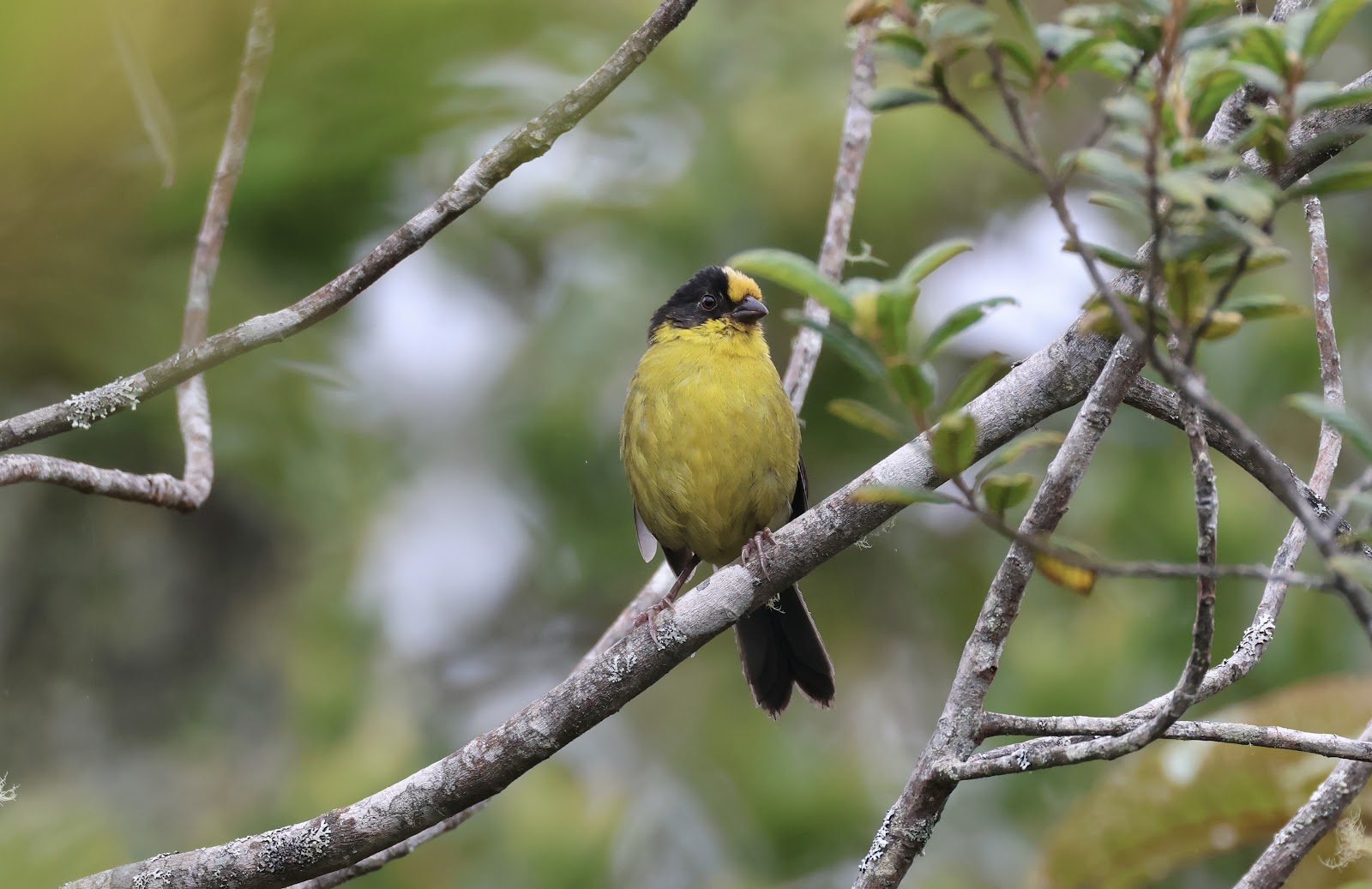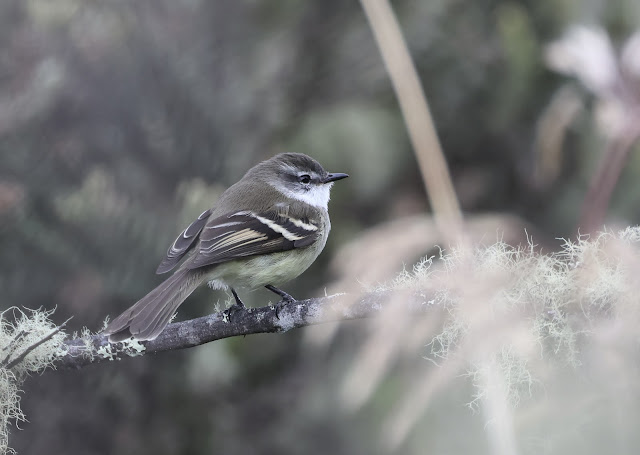To finish off the first full day in Colombia, we headed a little further into the Eastern Cordillera to a farm where an intrepid man has trained a family of Muisca Antpittas to come in for worms. The famous Angel Paz of Ecuador was the first known person to develop this practice and was dubbed the Antpitta Whisperer for it. This was revolutionary for birders looking for Antpittas to add to their lists because they are notoriously difficult to see. Angel was a farmer that learned that he could lure in the Antpittas by slowly developing trust with a mixture of calling to the birds and providing them worms reliably each day. Our local Colombian guide replicated this with the Muisca Antpitta.
We birded the road while we waited for our local guide to show up and found a few birds.
Pale-naped Brushfinch - we did see more of these later in the trip.
Golden-fronted Redstart - These are relatively common but something to note for potential future splits as the Eastern Cordillera birds have white around their eyes. The Central or Western Cordillera birds have yellow around the eyes.
Once we hooked up with the guide and hiked to the spot for the Muisca it didn't take long for it to show. These local guides know the individual birds and name them, I think this one was Señorita or something like that.
Muisca Antpittas were once part of the Rufous Antpitta complex which was split into 13 distinct species back in the early 2000s. The word Muisca comes from the indigenous peoples that inhabited this area of Colombia before the Spanish conquest.
The cool thing about these "trained" birds is that they teach their offspring to do the same thing so even if the trained bird dies off, the offspring will continue coming to the worm feedings and then all the time the local guides have invested can continue to benefit the locals for generations.
Speaking of subsequent generations, this is Senorita's offspring which is evident from the brighter rufous coloration.
The cows weren't impressed but I was.
It started to rain but we didn't let that stop us and birds don't seem to mind either. I suppose they have to keep foraging and are used to daily rain in Colombia even in the "dry season".
Brown-backed Chat-Tyrants were common throughout many places we visited in Colombia.
Mountain Caciques apparently have a wide distribution in the high elevations of the Andes but we only saw these once on the trip.
That was a wrap for the first day and we headed back to our hotel which was the Hilton Garden Inn by Bogota Airport where the rest of the tour participants joined us for dinner. I think that was the night the hotel we had our first power outage and also water restrictions imposed. That was something we would experience a couple times during the trip despite being in the largest metropolis in Colombia (7.7 Million people). However, the staff at the hotel took it in stride and made some good eats for us. I think we had our first taste of Ajiaco which is a Bogota regional soup kind of similar to Sancocho which I love. The soup is made with 3-4 different kinds of potatoes, chicken and a special herb called guasca. They usually serve it with a side of rice, corn, capers cream, and half an avocado.
The hotel was great, but I do think it was a bit of a mistake using a hotel in the middle of Bogota as a base for the first 3-4 nights. Traffic in Bogota is a nightmare, with motorcycles zipping all over with no apparent rules of the road. However, I get that it made sense due to arriving guests coming from the airport and it had all the amenities so I suppose I can't complain. We battled the traffic out of Bogota super early in the morning and made our way up to the famous Sumapaz National Park which is a high elevation site characterize by Paramo habitat.
The landscape is windswept and predominated by low scrub vegetation.
It looks like something out of a Dr Seuss book and is beautiful.
Apolinar's Wren! A Colombian endemic and very restricted to this paramo habitat.
Although superficially they look kind of like House Wrens, they sound very different.
The lifers started coming in fast. Basically every bird up here was new for me.
Red-crested Cotinga - we saw these only a couple times on the whole trip and they were both seen at a long distance.
Boyaca Antpitta - the interesting thing about Antpittas in Paramo habitat is that they seem to have lost their inhibitions with the lack of forest to hide in. They frequently can be seen out in the open. Boyaca Antpittas are another species we saw which has benefitted from a somewhat recent split. They previously were lumped in with Tawny Antpittas.
Andean Tit-spinetail is another high elevation species throughout the Andes.
The plants all the birds were perching on are almost as interesting as the birds.
Plumbeous Sierra Finches aren't really true finches but actually tanagers (Thraupidae family) that have developed into the same way of living as the finches. This species actually behaves much like a Junco.

Black-chested Buzzard-eagles are the most common raptor at this elevation and are interesting because the young ones don't just look different in coloration, they look different morphologically. Mainly the tail which looks like a normal raptor rail when young, but then something more vulturelike when adult. The above was a young bird.
And here is a beautiful adult bird. The tail almost blends in with the wing line.
Usually they are seen at a great distance so this look was exceptional.
The default Cinclodes species up here in the Eastern Cordillera is Chestnut-winged Cinclodes. Cinclodes are in the ovenbird family (no not the warbler Ovenbird, but the true ovenbirds in the family Furnariidae) and there are about a dozen or so species in South America.
We traveled a bit further into the park and ran into a Military Checkpoint. They made a few of us get out of the van and frisked us and our Colombian guide got really annoyed at the young soldiers for hassling us as clearly we were birders and not terrorists.
This Streak-throated Bush-Tyrant was super high up on a wire but the photos came out ok.
A Boyaca Antpitta out in the open!
A Many-striped Canastero was seen earlier but I missed a photo so I was jazzed when this one popped up and obliged. We never saw them again after that.
The real target for the day was the endemic Green-bearded Helmetcrest which is a stunning bird if you get the male in the right light. We unfortunately only found a female but the bonus was that we found a nesting female on nest!
The nest could only be seen if standing at the perfect angle from the road on an overhanging cliff-side.
Green-bearded Helmetcrest

Scarlet-bellied Mountain Tanagers are a huge crowd pleaser and we never got tired of them despite their relative abundance in a multitude of habitats throughout the trip.
White-throated Tyrannulet is a species I had seen on my last Colombia trip but it was good to get re-acquainted.
At around lunch time we left Sumapaz and headed down to have an authentic Ajiaco lunch at a local couple's house. I will pick up from there in the next post.


































No comments:
Post a Comment